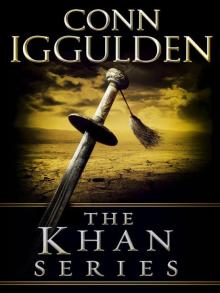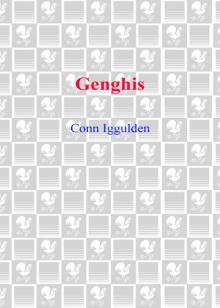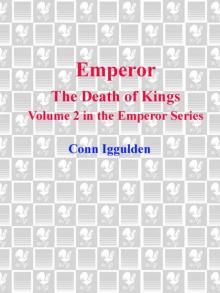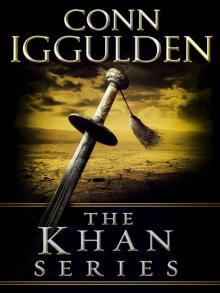- Home
- Conn Iggulden
The Dangerous Book for Boys Page 6
The Dangerous Book for Boys Read online
Page 6
Table Football
THIS IS A SIMPLE GAME, but it does require some skill and practice. It used to keep us occupied during French class.
* * *
You will need
A flat, smooth surface—a school table, for example.
Three quarters are best.
* * *
Place the coins on the close edge of the table, as in the diagram. The first blow must be struck with the heel of the hand against the coin half over the edge. The three coins will separate. From then on, only the coin closest to the player can be touched.
The aim of the game is to pass the coins up the table by firing the closest through the two farther up. If you don’t get the coin through, that’s the end of your go and your opponent begins again from his side of the table. Just one finger is usually used to flick the coins. They should always be in contact with the table, so a great deal of the skill is in judging the force as well as planning ahead.
After a few of these “passes,” the opposing goal comes into range. This is provided by the other player, as shown.
If the goal shot misses, the game is lost. If the shooting coin strikes one of the other two, the game is also lost.
In an advanced version of the game, tries are scored rather than goals, and they are worth five points. The scorer then has an opportunity to gain two more points by converting the try. This is difficult, to say the very least.
The opposing player rearranges his goal into a goal-post formation, as in the picture.
The goal or shooter coin must first be spun in place. As it spins, the coin must be gripped as shown in the picture and flipped over the posts in one smooth motion. No hesitation is allowed for aiming. This is not at all easy to do, which is as it should be.
Play to an agreed number, or perhaps to win the coins.
Fishing
ANGLERS ARE NOT PATIENT. Anticipation and concentration can make fishing an exhausting sport. It is a mainly solitary occupation. You hardly ever see people fishing in groups, laughing and chatting with each other, or drinking alcohol and singing. Anglers can spend the day in silence. Even if you never catch anything, lazy afternoons spent fishing in the summer can be relaxing, rewarding—and addictive.
A simple starter kit—a rod, bait, a float, a lead weight, and a hook—can be put together for about $20. As a legal requirement, you may need to purchase a fishing license. Check your state and local laws to see what permits might be required. The local fishing store will have the equipment and be able to give you good advice about licenses and local fishing grounds.
The classic fishing method is with a float. Maggots from bluebottle or greenbottle flies are spiked on a hook suspended from a float that bobs on the surface. Push the hook through the blunt end of the maggot, taking care not to burst it, as it dies faster.
It tends to be necessary to place a couple of ball lead weights on the line to keep the float upright. Ask in the fishing store if you’re not sure how.
Cast carefully as a hook catching in your eyebrow is a deeply unpleasant experience. Watch out for overhead cables or tree branches. Your basic reel will have two settings—one for casting and one for retrieving the hook. Allow it to run loose and cast the hook and float upstream and allow the hook to come downstream toward you in the current. The first moment when that float dips is an experience to be treasured. Otherwise, wind back in slowly and try it again, replacing your maggots when they no longer move. If it’s a nice day, find a place to sit and enjoy the peace that lasts until someone comes along and says, “Any luck?”
The second classic method involves a heavier lead weight that keeps the hook on the bottom. Fish taking the bait feel no resistance. This works well with carp.
It should be clear that the method depends on the fish. Pike and perch tend to attack injured or dying fish. As a result, they can be caught using a “spinner,” a device that resembles a wounded fish as it moves through the water. Many anglers use complex lures that mimic insects on the surface. For a beginner, though, you’d hope to catch one of the following:
Brook Trout
Brook trout (Salvelinus fontinalis). A group of trout is called a hover, and these can usually be found in spring-fed lakes, streams, and ponds with sand and gravel bottoms. This is a beautiful, speckled fish that eight states, including Vermont and New York, claim as their official symbol.
Pike
Pike (Esox lucieus). Pike are greenish with bright yellow eyes, and while they usually weight a few pounds when you catch them, old fish that have avoided the lure for years can reach up to twenty pounds.
Smallmouth bass
Smallmouth bass (Micropterus dolomieui). Bass are green with a white underside. They love to eat crayfish, but in the winter, they fast and hide at the bottom of lakes and rivers. You might also encounter the largemouth bass, which is almost identical to its smaller cousin.
Walleye
Walleye (Stizostedion vitreum). Walleyes, the favorite game fish of many Americans, especially in the Midwest, are really huge perch, and taste just as nice. Walleye season starts in the middle of May.
Minnow
Minnows. The tiny fish whose name has actually come to mean “small and insignificant.”
There are too many other types to include here—the rivers and lakes teem with them.
“Game fishing” is a specific reference to the salmon family: salmon, trout, char and grayling. “Coarse” fish have five fins—ventral, anal, dorsal, pectoral and caudal. Members of the salmon family all have one extra fin close to the tail—known as the adipose fin. Salmon are born from eggs laid in rivers and swim to the sea, where they live for one to three years. After that, they return by instinct to the river where they were born to breed, in what is known as the “spawning season.” They are caught as they travel upstream, with a lure containing a hook.
Catching a fish can be exciting—the real skill is not in hooking one but in bringing it in without breaking the line or losing the fish. As a final note, try reading the classic fishing tale by Ernest Hemingway,—The Old Man and the Sea. Happy fishing.
Timers and Tripwires
* * *
You will need
An old alarm clock.
Bulb.
Two pieces of insulated electrical wire with bare copper ends.
Adhesive tape.
A battery—C or D size.
* * *
These are very simple to make—and deeply satisfying. For the timer, any windup alarm clock will do—preferably one with plastic hands. The idea is to use the clock to complete a circuit and turn on a light. You want the bulb to turn on in twenty minutes—to win a bet perhaps, or to frighten your little sister with the thought that a mad axe murderer is upstairs.
First, remove the plastic front of the clock. Tape wire to each hand, so that when one passes under the other, the bare ends will touch. It should be clear that a circuit can now be made with a time delay of however long it takes the minute hand to travel around and touch the hour hand.
Attach one of the wires to a positive battery terminal. Tape a flashlight bulb to the negative terminal and the end of the other wire to the end of the bulb. Test it a few times by touching the hands of the clock together. The bulb should light as the wires on the hands touch and complete the circuit.
Bear in mind that the hour hand will have moved by the time the minute hand comes around, so it’s worth timing how long it takes for the bulb to light after setting the minute hand to, say, fifteen minutes before the hour. You can then terrify your young sister with the tale of the man with a hook for a hand.
TRIPWIRE
This is almost the same thing, in that it uses a battery circuit with a bulb linked to a switch—in this case a tripwire. With a long enough wire, the bulb can be lit some way from the actual trip switch for longer warning times.
* * *
You will need
Clothes pin.
Wine cork.
Tin foil.
Fi
shing line or string.
Battery, bulb and insulated wire, as with the timer setup.
Adhesive tape.
* * *
Wrap foil around the ends of the wooden or plastic clothes pin. Attach your wires with tape to those foil ends, running both to exactly the same battery-and-bulb setup as the alarm-clock switch above.
The important thing is to have a nonconducting item between the jaws of the clothes pin. We found a wine cork worked quite well. The wire itself must also be strong enough to pull the cork out—if it snaps, the bulb won’t light. Fishing wire is perfect for this, as it’s strong and not that easy to see. It is also important to secure the clothes pin under a weight of some kind. Only the cork should move when the wire is pulled.
When the cork is pulled out, the jaws of the pin snap shut, touching the foil ends together, completing the circuit and lighting the bulb to alert you.
This works especially well in long grass, but its main disadvantage is that whoever trips the switch tends to know it has happened. Enemy soldiers would be put on the alert, knowing they were in trouble. Of course, in a real conflict, the wire would have pulled out the pin to a grenade.
PRESSURE PLATE
One way of setting up a trip warning without the person realizing is with a pressure plate. Again, this relies on a simple bulb circuit, but this time the wires go to two pieces of cardboard held apart by a piece of squashable foam such as you might find in children’s blocks. A bit of sponge would also be perfect.
This time, tape foil squares over the bare ends of the wires on the inner surfaces of the cardboard and set up a simple bulb and battery circuit as before. With only light pressure from above, the two bits of cardboard come together, bringing the foil squares into contact. The circuit is made and the warning bulb comes on. Enjoy.
Baseball’s “Most Valuable Players”
BASEBALL IS still America’s national pastime and each spring, hundreds of thousands of people swarm to parks and stadiums to watch their favorite teams duke it out on the field.
The first mention of baseball in the United States was published in a city statute in Pittsfield, Massachusetts, in 1791. The bylaw prohibited the playing of baseball within eighty yards of the local meetinghouse. Professional baseball began to be played in the 1860s. Ten years later, newspapers began calling the sport “The National Pastime.”
The first major league was the National Association, established in 1871. It lasted only four years, and shut down in 1875. The National League was founded a year later, in 1876. There were other major leagues that failed, but the National League still exists, as does the American League, which began in 1901. The American League began as the Western League, a minor league.
The Major League Baseball season begins in April (or late March) and runs into October. The season includes the regular season, the play-offs, and the World Series. Every team wants to win the World Series, the championship series of the major league. The championships are played between the American League and National League champions in a best-of-seven play-off. The New York Yankees have the most World Series titles: as of this writing, they have won twenty-six championships.
For an individual player, the biggest honor in baseball is to be named Most Valuable Player. Each year, the Baseball Writers Association of America determines who the MVPs are. We list them here for you, going back to 1931.
MOST VALUABLE PLAYERS
AMERICAN LEAGUE
Year Player Team Pos.
2006 Justin Morneau Minnesota 1B
2005 Alex Rodriguez New York 3B
2004 Vladimir Guerrero Anaheim RF
2003 Alex Rodriguez Texas SS
2002 Miguel Tejada Oakland SS
2001 Ichiro Suzuki Seattle RF
2000 Jason Giambi Oakland 1B
1999 Ivan Rodriguez Texas C
1998 Juan Gonzalez Texas OF
1997 Ken Griffey, Jr. Seattle OF
1996 Juan Gonzalez Texas OF
1995 Mo Vaughn Boston 1B
1994 Frank Thomas Chicago 1B
1993 Frank Thomas Chicago 1B
1992 Dennis Eckersley Oakland P
1991 Cal Ripken, Jr. Baltimore SS
1990 Rickey Henderson Oakland OF
1989 Robin Yount Milwaukee OF
1988 Jose Canseco Oakland OF
1987 George Bell Toronto OF
1986 Roger Clemens Boston P
1985 Don Mattingly New York 1B
1984 Willie Hernandez Detroit P
1983 Cal Ripken, Jr. Baltimore SS
1982 Robin Yount Milwaukee SS
1981 Rollie Fingers Milwaukee P
1980 George Brett Kansas City 3B
1979 Don Baylor California OF
1978 Jim Rice Boston OF
1977 Rod Carew Minnesota 1B
1976 Thurman Munson New York C
1975 Fred Lynn Boston OF
1974 Jeff Burroughs Texas OF
1973 Reggie Jackson Oakland OF
1972 Richie Allen Chicago 1B
1971 Vida Blue Oakland P
1970 Boog Powell Baltimore 1B
1969 Harmon Killebrew Minnesota 1B/3B
1968 Denny McLain Detroit P
1967 Carl Yastrzemski Boston OF
1966 Frank Robinson Baltimore OF
1965 Zoilo Versalles Minnesota SS
1964 Brooks Robinson Baltimore 3B
1963 Elston Howard New York C
1962 Mickey Mantle New York OF
1961 Roger Maris New York OF
1960 Roger Maris New York OF
1959 Nellie Fox Chicago 2B
1958 Jackie Jensen Boston OF
1957 Mickey Mantle New York OF
1956 Mickey Mantle New York OF
1955 Yogi Berra New York C
1954 Yogi Berra New York C
1953 Al Rosen Cleveland 3B
1952 Bobby Shantz Philadelphia P
1951 Yogi Berra New York C
1950 Phil Rizzuto New York SS
1949 Ted Williams Boston OF
1948 Lou Boudreau Cleveland SS
1947 Joe DiMaggio New York OF
1946 Ted Williams Boston OF
1945 Hal Newhouser Detroit P
1944 Hal Newhouser Detroit P
1943 Spud Chandler New York P
1942 Joe Gordon New York 2B
1941 Joe DiMaggio New York OF
1940 Hank Greenberg Detoit OF
1939 Joe DiMaggio New York OF
1938 Jimmie Foxx Boston 1B
1937 Charlie Gehringer Detroit 2B
1936 Lou Gehrig New York 1B
1935 Hank Greenberg Detroit 1B
1934 Mickey Cochrane Detroit C
1933 Jimmie Foxx Philadelphia 1B
1932 Jimmie Foxx Philadelphia 1B
1931 Lefty Grove Philadelphia P
NATIONAL LEAGUE
Year Player Team Pos.
2006 Ryan Howard Philadelphia 1B
2005 Albert Pujols St. Louis 1B
2004 Barry Bonds San Fran LF
2003 Barry Bonds San Fran LF
2002 Barry Bonds San Fran LF
2001 Barry Bonds San Fran LF
2000 Jeff Kent San Fran 2B
1999 Chipper Jones Atlanta 3B
1998 Sammy Sosa Chicago OF
1997 Larry Walker Colorado OF
1996 Ken Caminiti San Diego 3B
1995 Barry Larkin Cincinnati SS
1994 Jeff Bagwell Houston 1B
1993 Barry Bonds San Fran OF
1992 Barry Bonds Pittsburgh OF
1991 Terry Pendleton Atlanta 3B
1990 Barry Bonds Pittsburgh OF
1989 Kevin Mitchell San Fran OF
1988 Kirk Gibson Los Angeles OF
1987 Andre Dawson Chicago OF
1986 Mike Schmidt Philadelphia 3B
1985 Willie McGee St. Louis OF
1984 Ryne Sandberg Chicago 2B
1983 Dale Murphy Atlanta OF
1982 Dale Murphy Atlanta OF
1981 Mike Schmidt Philadelphi
a 3B
1980 Mike Schmidt Philadelphia OF
1979 Keith Hernandez St. Louis 1B
Willie Stargell Pittsburgh 1B
1978 Dave Parker Pittsburgh OF
1977 George Foster Cincinnati OF
1976 Joe Morgan Cincinnati 2B
1975 Joe Morgan Cincinnati 2B
1974 Steve Garvey Los Angeles 1B
1973 Pete Rose Cincinnati OF
1972 Johnny Bench Cincinnati C
1971 Joe Torre St. Louis 3B
1970 Johnny Bench Cincinnati C
1969 Willie McCovey San Fran 1B
1968 Bob Gibson St. Louis P
1967 Orlando Cepeda St. Louis 1B
1966 Roberto Clemente Pittsburgh OF
1965 Willie Mays San Fran OF
1964 Ken Boyer St. Louis 3B
1963 Sandy Koufax Los Angeles P
1962 Maury Wills Los Angeles SS
1961 Frank Robinson Cincinnati OF
1960 Dick Groat Pittsburgh SS
1959 Ernie Banks Chicago SS
1958 Ernie Banks Chicago SS
1957 Hank Aaron Milwaukee OF
1956 Don Newcombe Brooklyn P
1955 Roy Campanella Brooklyn C
1954 Willie Mays New York OF
1953 Roy Campanella Brooklyn C
1952 Hank Sauer Chicago OF
1951 Roy Campanella Brooklyn C
1950 Jim Konstanty Philadelphia P
1949 Jackie Robinson Brooklyn 2B
1948 Stan Musial St. Louis OF
1947 Bob Elliott Boston 3B
1946 Stan Musial St. Louis 1B

 The Khan Series 5-Book Bundle
The Khan Series 5-Book Bundle Tollins 2: Dynamite Tales
Tollins 2: Dynamite Tales Tollins: Explosive Tales for Children
Tollins: Explosive Tales for Children The Field of Swords
The Field of Swords The Death of Kings
The Death of Kings Quantum of Tweed: The Man With the Nissan Micra
Quantum of Tweed: The Man With the Nissan Micra Bones of the Hills
Bones of the Hills Genghis: Birth of an Empire
Genghis: Birth of an Empire The Gates of Rome
The Gates of Rome Dunstan
Dunstan Fig Tree
Fig Tree The Gates of Athens
The Gates of Athens Stormbird
Stormbird Khan: Empire of Silver
Khan: Empire of Silver The Abbot's Tale
The Abbot's Tale Gengis: Lords of the Bow
Gengis: Lords of the Bow The Gods of War
The Gods of War Blackwater
Blackwater Ravenspur: Rise of the Tudors
Ravenspur: Rise of the Tudors Wars of the Roses: Trinity (War of the Roses Book 2)
Wars of the Roses: Trinity (War of the Roses Book 2) The Gods of war e-4
The Gods of war e-4 The Dangerous Book of Heroes
The Dangerous Book of Heroes Stormbird wotr-1
Stormbird wotr-1 Emperor: The Death of Kings
Emperor: The Death of Kings Conqueror (2011) c-5
Conqueror (2011) c-5 The Dangerous Book for Boys
The Dangerous Book for Boys Genghis Lords of the Bow
Genghis Lords of the Bow Emperor: The Blood of Gods (Special Edition) (Emperor Series, Book 5)
Emperor: The Blood of Gods (Special Edition) (Emperor Series, Book 5) The Emperor Series: Books 1-5
The Emperor Series: Books 1-5 Lords of the Bow c-2
Lords of the Bow c-2 Lords of the Bow
Lords of the Bow Quantum of Tweed
Quantum of Tweed Wars of the Roses 01 - Stormbird
Wars of the Roses 01 - Stormbird Empire of Silver c-4
Empire of Silver c-4 Birth of an Empire
Birth of an Empire Conqueror (2011)
Conqueror (2011) Wars of the Roses: Bloodline: Book 3 (The Wars of the Roses)
Wars of the Roses: Bloodline: Book 3 (The Wars of the Roses) Bones Of the Hills c-3
Bones Of the Hills c-3 Empire of Silver
Empire of Silver The Khan Series 5-Book Bundle: Genghis: Birth of an Empire, Genghis: Bones of the Hills, Genghis: Lords of the Bow, Khan: Empire of Silver, Conqueror
The Khan Series 5-Book Bundle: Genghis: Birth of an Empire, Genghis: Bones of the Hills, Genghis: Lords of the Bow, Khan: Empire of Silver, Conqueror The Falcon of Sparta
The Falcon of Sparta Explosive Tales for Children
Explosive Tales for Children